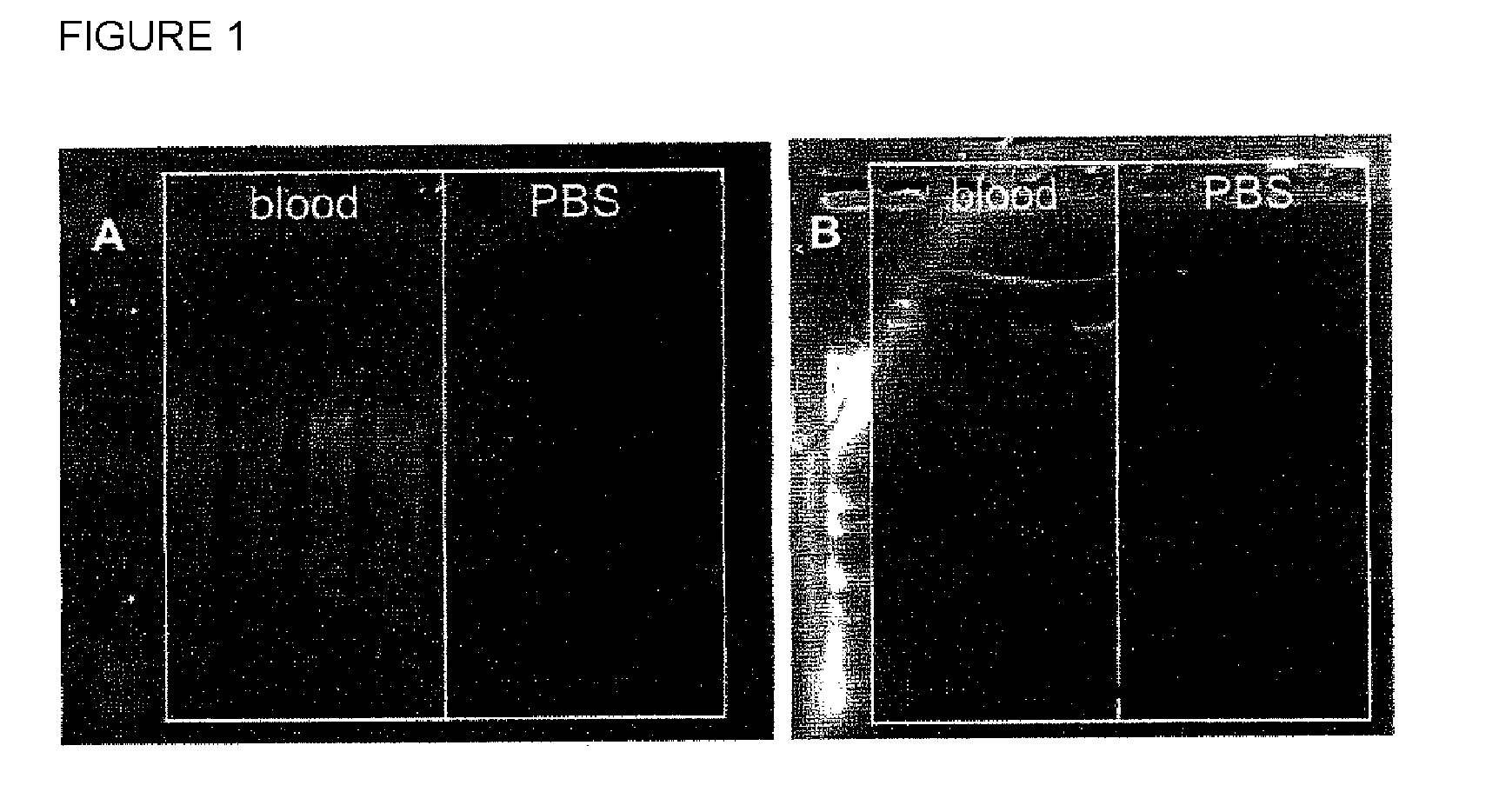Diagnostic reagent, containing bioparticles, method for production thereof and use thereof as internal standard in nucleic acid preparation and nucleic acid detection methods
- Summary
- Abstract
- Description
- Claims
- Application Information
AI Technical Summary
Benefits of technology
Problems solved by technology
Method used
Image
Examples
example 1
Production of Tablets
[0129]a) Tablet A (Corynebacterium glutamicum)
[0130]3 g of hydroxyethyl starch, 0.5 ml of 20% PEG 8000, 1.5 ml of TE (10 mM Tris-Cl, pH 8.0, 1 mN EDTA), 1.5 ml of an overnight culture of Corynebacterium glutamicum (obtained as described above) in 2YT medium (yeast extract tryptone medium), and a few crumbs of fuchsine (Fluka) are added to a single-use weighing dish and mixed to a homogeneous mass with a spatula. The mass is transferred to a syringe with the spatula and portioned onto Parafilm film as small beads (diameter of 1-2 mm) via a blunt cannula. Subsequently, the tablets obtained are dried overnight in the fume cupboard. There are obtained in this way, depending on the aliquots used, 50 to 200 tablets.
b) Tablet B (Corynebacterium glutamicum)
[0131]1 g of hydroxyethyl starch, 500 of 20% PEG 8000, 500 of an overnight culture of Corynebacterium glutamicum in 2YT medium (obtained as described above), 1 small spatula tip of methylene blue, 750 of Buffer P (1.4...
example 2
Nucleic Acid Preparation and Nucleic Acid Amplification
a) Lysis / preparation
[0136]One each of Tablet A was added to a 2 ml tube, and 200 μl of blood (example 2a) or 200 μl of PBS buffer (example 2b) were added. To each tube, 20 μl of QIAGEN proteinase K solution and 40 μl of lysozyme solution (20 mg / ml in water in each case) were added in each case. The incubation was carried out over 10 minutes at 56° C. on an Eppendorf Thermomixer at a shaking speed of 1400 rpm. Subsequently, 200 μl of Buffer G (3 M GITC (guanidinium thiocyanate), 20% Nonidet® P40) were added, and reincubation was carried out over 10 minutes at 56° C. on an Eppendorf Thermomixer at a shaking speed of 1400 rpm. Then, 200 μl of ethanol were added and mixed well with the tube content.
b) Purification
[0137]The following steps were then carried out according to the QIAamp DNA Micro Handbook with each of the two samples:[0138]Binding: the entire mixture was added to a QIAamp MinElute spin column and centrifuged for 1 minu...
example 3
Quantitative PCR (Specific for C. glutamicum)
[0149]The real-time PCR specific for C. glutamicum was carried out with 10.0 μl of QIAGEN QuantiTect Probe PCR Master Mix, 0.1 μl of CG Forward (SEQ ID NO: 1) (100 μM), 0.10 μl of CG Reverse (SEQ ID NO: 2) (100 μM), 0.05 μl of CG Probe (SEQ ID NO: 3) (100 μM), 7.75 μl of double-distilled water, and 2.0 μl of template aliquots of the eluates obtained in example 2 with blood and PBS samples with, in each case, tablets A and B. The temperature cycles were 15 minutes at 95° C. and 40×(15 seconds at 95° C., 1 minute at 60° C.). The amplification was carried out in each case with eluates of 4 individual nucleic acid preparations.
[0150]The results are shown in FIG. 2. The histogram shows the amount of C. glutamicum DNA detected by means of the PCR (in pg) per reaction with a sample size of 4. In each case, the Ct values in the RT-PCR were determined by means of fluorescence spectroscopy. With the aid of a calibration curve, the respective starti...
PUM
| Property | Measurement | Unit |
|---|---|---|
| Mass | aaaaa | aaaaa |
| Mass | aaaaa | aaaaa |
| Mass | aaaaa | aaaaa |
Abstract
Description
Claims
Application Information
 Login to View More
Login to View More - R&D
- Intellectual Property
- Life Sciences
- Materials
- Tech Scout
- Unparalleled Data Quality
- Higher Quality Content
- 60% Fewer Hallucinations
Browse by: Latest US Patents, China's latest patents, Technical Efficacy Thesaurus, Application Domain, Technology Topic, Popular Technical Reports.
© 2025 PatSnap. All rights reserved.Legal|Privacy policy|Modern Slavery Act Transparency Statement|Sitemap|About US| Contact US: help@patsnap.com



